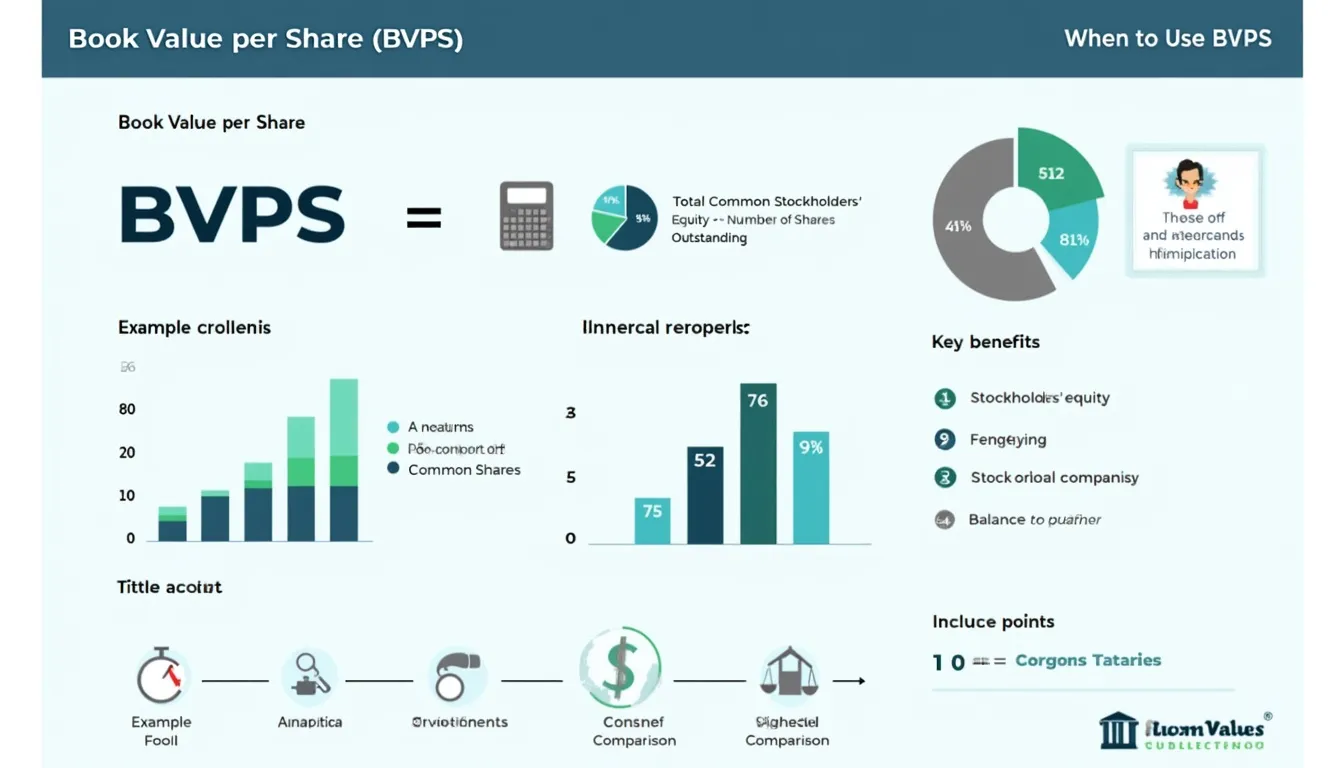Book Value per Share Calculator
Is this tool helpful?
How to Use the Book Value per Share Calculator Effectively
Our Book Value per Share Calculator is a powerful tool designed to help investors, financial analysts, and business owners quickly determine the per-share value of a company based on its equity available to common shareholders. To use this calculator effectively, follow these simple steps:
- Enter the Total Common Stockholders’ Equity in dollars
- Input the Number of Common Shares outstanding
- Click the “Calculate” button
- View the resulting Book Value per Share displayed below
It’s important to note that all inputs should be positive numbers, and the number of shares must be greater than zero. The calculator will automatically validate your inputs to ensure accuracy.
Understanding Book Value per Share: Definition, Purpose, and Benefits
Book Value per Share (BVPS) is a fundamental financial metric that provides insight into a company’s net asset value on a per-share basis. It’s calculated using the following formula:
$$ \text{Book Value per Share} = \frac{\text{Total Common Stockholders' Equity}}{\text{Number of Common Shares Outstanding}} $$The purpose of this metric is to give investors and analysts a quick way to assess the minimum value of a company’s equity in a worst-case scenario (e.g., liquidation). It represents the per-share value of the company based on its historical costs or accounting value.
Key benefits of understanding and calculating Book Value per Share include:
- Providing a baseline for company valuation
- Identifying potentially undervalued stocks
- Comparing companies within the same industry
- Assessing a company’s financial health
- Determining the impact of share buybacks or issuances
The Advantages of Using Our Book Value per Share Calculator
Our Book Value per Share Calculator offers several advantages for users looking to quickly and accurately determine this important financial metric:
- Time-saving: Instantly calculate BVPS without manual computations
- Accuracy: Eliminate human error in calculations
- User-friendly interface: Easy-to-use design for both financial experts and novices
- Responsive layout: Access the calculator on various devices, from desktops to smartphones
- Real-time results: Get immediate feedback as you input your data
- Educational tool: Learn about BVPS while using the calculator
Addressing User Needs and Solving Specific Problems
Our Book Value per Share Calculator addresses several key user needs and solves specific problems in the realm of financial analysis:
1. Quick Valuation Assessment
For investors and analysts who need to rapidly assess a company’s baseline value, our calculator provides instant results. This is particularly useful when screening multiple stocks or comparing companies in a time-sensitive environment.
2. Educational Support
Finance students and those new to investing can use this tool to better understand the concept of Book Value per Share. The calculator’s straightforward interface helps reinforce the relationship between a company’s equity and its outstanding shares.
3. Decision-Making Aid
Investors can use the BVPS calculation to make more informed decisions about potential investments. By comparing a stock’s market price to its book value per share, users can identify potentially undervalued or overvalued securities.
4. Financial Reporting Assistance
For small business owners or financial professionals preparing reports, our calculator streamlines the process of determining BVPS, ensuring accuracy and consistency in financial statements.
5. Trend Analysis
By using the calculator regularly with updated financial data, users can track changes in a company’s BVPS over time, providing insights into the company’s financial health and growth.
Practical Applications and Use Cases
To illustrate the practical applications of our Book Value per Share Calculator, let’s explore some real-world use cases:
Case Study 1: Value Investing
Sarah, an experienced value investor, is searching for undervalued stocks in the technology sector. She uses our calculator to determine the BVPS for several companies:
- Company A: BVPS = $15.50, Current Market Price = $14.75
- Company B: BVPS = $22.30, Current Market Price = $35.60
- Company C: BVPS = $18.75, Current Market Price = $17.90
Sarah identifies Companies A and C as potential value investments, as their market prices are below their book values per share. She then conducts further research to determine if these stocks are truly undervalued or if there are underlying issues causing the low market price.
Case Study 2: Financial Analysis for a Growing Company
John, a financial analyst at a rapidly growing startup, uses our Book Value per Share Calculator to track the company’s financial progress over three years:
- Year 1: Total Equity = $5,000,000, Shares Outstanding = 1,000,000, BVPS = $5.00
- Year 2: Total Equity = $7,500,000, Shares Outstanding = 1,100,000, BVPS = $6.82
- Year 3: Total Equity = $12,000,000, Shares Outstanding = 1,200,000, BVPS = $10.00
By tracking the BVPS growth, John can demonstrate to investors and stakeholders that the company is effectively increasing shareholder value over time.
Case Study 3: Comparing Companies in the Same Industry
Emily, a portfolio manager, is evaluating three retail companies for potential investment. She uses our calculator to determine their respective Book Values per Share:
- Retailer X: BVPS = $45.20
- Retailer Y: BVPS = $38.75
- Retailer Z: BVPS = $52.90
While this information alone isn’t sufficient for making an investment decision, it provides Emily with a starting point for comparing the companies’ financial positions. She can now investigate why Retailer Z has a significantly higher BVPS and whether this translates to a stronger overall financial position.
Frequently Asked Questions (FAQ)
Q1: What exactly does Book Value per Share represent?
A1: Book Value per Share represents the net asset value of a company on a per-share basis. It’s calculated by dividing the total common stockholders’ equity by the number of outstanding common shares. This metric gives an indication of the minimum value of a company’s equity in a worst-case scenario, such as liquidation.
Q2: How often should I calculate Book Value per Share?
A2: For publicly traded companies, it’s common to calculate BVPS quarterly when new financial statements are released. For private companies or personal use, calculating BVPS annually or semi-annually is usually sufficient, unless there are significant changes in the company’s equity or number of outstanding shares.
Q3: Is a higher Book Value per Share always better?
A3: While a higher BVPS can indicate a stronger financial position, it’s not always better in isolation. It’s important to consider other factors such as the company’s growth rate, industry standards, and overall financial health. Some successful companies may have a lower BVPS due to aggressive reinvestment in the business.
Q4: How does Book Value per Share relate to market value?
A4: Book Value per Share is based on historical costs and accounting value, while market value reflects current investor sentiment and future growth expectations. Comparing BVPS to market price can help identify potentially undervalued or overvalued stocks. A price-to-book ratio (market price divided by BVPS) is often used for this comparison.
Q5: Can Book Value per Share be negative?
A5: Yes, BVPS can be negative if a company’s liabilities exceed its assets, resulting in negative equity. This is generally a red flag, indicating significant financial distress. However, it’s important to consider the context, as some young, high-growth companies might temporarily have negative equity while investing heavily in future growth.
Q6: How does stock dilution affect Book Value per Share?
A6: Stock dilution, which occurs when a company issues new shares, typically decreases BVPS if the new shares are issued at a price below the current BVPS. This is because the total equity is spread across a larger number of shares. Conversely, if shares are repurchased, BVPS usually increases as the equity is concentrated among fewer shares.
Q7: Are there any limitations to using Book Value per Share?
A7: Yes, there are several limitations to consider:
- It doesn’t account for intangible assets like brand value or intellectual property
- It’s based on historical costs, which may not reflect current market values
- Different accounting methods can affect the calculation
- It doesn’t consider a company’s future growth prospects
- It may not be as relevant for service-based or technology companies with few tangible assets
Conclusion: Harnessing the Power of Book Value per Share
Our Book Value per Share Calculator is an invaluable tool for investors, analysts, and financial professionals seeking to quickly and accurately determine a company’s per-share equity value. By providing instant calculations and a user-friendly interface, this calculator streamlines financial analysis and decision-making processes.
Key benefits of using our BVPS calculator include:
- Time-saving automation of calculations
- Improved accuracy in financial analysis
- Easy comparison of companies within the same industry
- Identification of potentially undervalued stocks
- Tracking of a company’s financial health over time
- Educational support for finance students and new investors
While Book Value per Share is just one of many financial metrics to consider when evaluating a company, it provides a solid foundation for further analysis. By understanding and regularly calculating BVPS, you can gain valuable insights into a company’s financial position and make more informed investment decisions.
We encourage you to bookmark our Book Value per Share Calculator and make it a regular part of your financial analysis toolkit. Whether you’re a seasoned investor, a financial professional, or just starting your journey in the world of finance, this powerful yet simple tool can help you unlock the true worth of companies and make smarter, data-driven decisions.
Start using our Book Value per Share Calculator today and take your financial analysis to the next level!
Important Disclaimer
The calculations, results, and content provided by our tools are not guaranteed to be accurate, complete, or reliable. Users are responsible for verifying and interpreting the results. Our content and tools may contain errors, biases, or inconsistencies. We reserve the right to save inputs and outputs from our tools for the purposes of error debugging, bias identification, and performance improvement. External companies providing AI models used in our tools may also save and process data in accordance with their own policies. By using our tools, you consent to this data collection and processing. We reserve the right to limit the usage of our tools based on current usability factors. By using our tools, you acknowledge that you have read, understood, and agreed to this disclaimer. You accept the inherent risks and limitations associated with the use of our tools and services.







